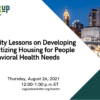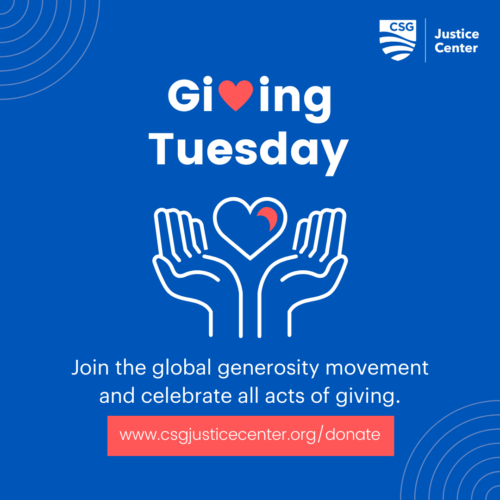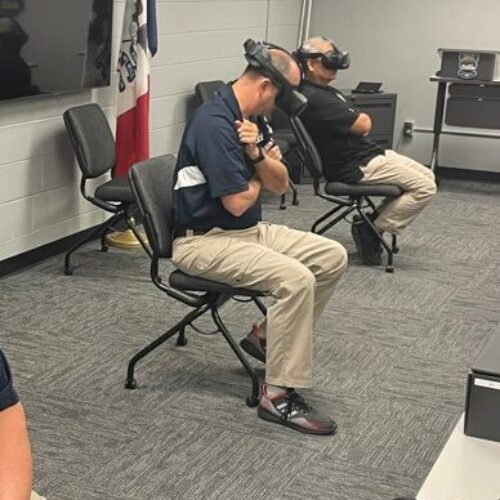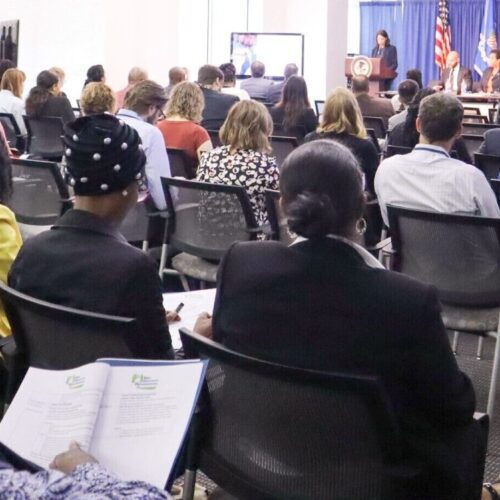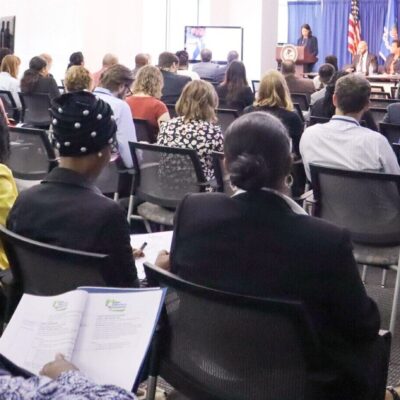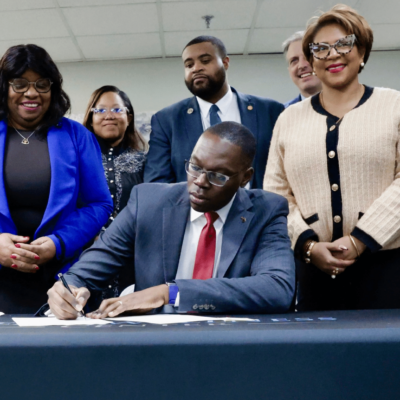More Community, Less Confinement: How Supervision Violations Impacted Prison Admissions During the Pandemic
Please note that this event was rescheduled from August 12. Individuals who registered prior to the date change will continue to receive event information.
The pandemic forced changes in probation and parole that resulted in unprecedented drops in the number of people admitted to prison due to supervision violations. Now, state leaders face a critical question: What changes should be carried forward?
Join The Council of State Governments (CSG) Justice Center for a Justice Briefing Live event to mark the launch of our new, nationwide analysis of probation and parole. A data presentation and panel discussion will explore changes that contributed to declines in the number of prison admissions due to supervision violations. Given that supervision violations still make up a large share of prison admissions, the panel discussion will also explore what changes still need to happen in community supervision.
The livestream event will bring together state corrections officials, people with experience on community supervision, policymakers, and advocates. It is free and open to the public; pre-registration is encouraged.
Panel Discussion:
The discussion will focus on these key questions/concepts:
- Why and how have community supervision programs changed or shifted prior to or during the pandemic?
- What specific changes have states prioritized and why? Have they seen positive outcomes? If not yet, what kinds of outcomes do they expect to see?
- What still needs to happen or be addressed in community supervision to allow for better outcomes for people on probation or parole?
- How can we carry these changes forward? What will the barriers be for doing so? What challenges might exist?
Research Presentation: Jessica Saunders, Director of Research, The CSG Justice Center
Panelists:
- Dylan Hayre, Director of Criminal Justice, Arnold Ventures
- Orlando Mayorga, McCormick Reentry Coordinator Fellow, Office of the Illinois Lt. Governor, Juliana Stratton
- Louis Reed, Senior Director, Memberships & Partnerships, REFORM Alliance
- Beth Skinner, Director, Iowa Department of Corrections
Video Transcript
Text Transcript
Nicole Jarrett: Good afternoon, everyone. And welcome to today’s Justice Briefing Live event. The Council of State Governments Justice Center is a national, non-profit, non-partisan organization. We represent state officials across all three branches of government and in all 50 states. We strive to uphold justice, offer second chances, and ensure safe and healthy communities. My name is Dr. Nicole Jarrett, and I lead the Corrections and Reentry division at the CSG Justice Center. I am delighted to welcome folks here, tuning across from all across the country to mark the release of our latest national survey and report.
The report, More Community, Less Confinement, is available today on our website at csgjusticecenter.org. There you can view national trends, as well as dig into your state’s data. We are grateful to have two excellent partners on this project. The Corrections Leader Associations who helped produce the report, and Arnold Ventures who supported the work. And of course we thank our colleagues in 49 states who shared and reviewed their state’s data.
Today’s event will happen in two parts, and I’d like to introduce the two women that will be leading the program. First, my colleague, Dr. Jessica Saunders will walk us through the findings of the study. Dr. Saunders served as the principal investigator of the study, leading the CSG Justice Center team, who conducted our nationwide analysis on probation and parole.
Following the research presentation, we have an all star panel lined up, and this conversation will be led by NPRs Carry Johnson. Since 2000, Ms. Johnson has reported in all things justice, law enforcement and legal affairs for NPRs flagship programs, Morning Edition, and All Things Considered. Her accomplishments are numerous. She’s been honored by the Robert F. Kennedy Center for Justice and Human Rights, and has been a finalist for the Pulitzer Prize in Breaking News. You can count me in among the many fans who always appreciate listening to her voice, and today we are delighted to see her face. Thank you for being here.
Finally, some quick housekeeping items before we dive in. We encourage you to join in today’s discussion with comments and questions. You can do this in two ways. Our social media using the hashtag justice briefing live, or in the Vimeo comments box below the broadcast. Our team is standing by, ready to respond. A recording and a transcript of today’s events will be made available at csgjusticecenter.org in the coming days. And with that, let’s dig into the findings of More Community, Less Confinement. Dr. Saunders, I hand it over to you.
Jessica Saunder…: Thank you so much, Nicole. Hi, everyone. I’m Dr. Jessica Saunders, the research director here at the CSG Justice Center. Today we’re going to review the findings of our 50 state survey of prison populations and explore how dynamics changed during the first year of the COVID-19 pandemic. I’m going to give a brief presentation of our research findings, point you to some resources, and then we’ll move on to listening to our esteemed panelists. So bottom line upfront, just to give everything away. Thanks to the data provided by nearly every state correctional department, our findings help us understand three main things. First, prison populations dropped dramatically, and contrary to common assumption, it was mostly due to fewer admissions, not necessarily increased releases.
Two, supervision violations have a huge impact on prison admissions and populations. During the pandemic fewer people were sent to prison for supervision violations, explaining about a third of the drop in the prison population. And yet, even during the pandemic, 98,000 people were sent to prison in 2020 for technical violations, signaling that much more can be done to promote success for people on supervision.
So let’s start with why this study matters. Budget challenges always weigh heavily on corrections administrators and their staff, and the need for data informed decision-making is more pressing than ever. Our 2019 groundbreaking report provided the first national and state by state study that quantified the cost of community supervision failure on prison operations and budgets. We found that close to half of all admissions to prison were comprised of individuals who violated their community supervision conditions. One in four people, that’s 25% in prison were there for violating the terms of their community supervision. Those numbers varied quite a bit by state. We found that in 13 states over one third of their prison population was there for violating community supervision conditions.
And lastly, incarcerating these individuals cost states over $9.3 billion each year. We’re just going to quickly go over a couple of key terms so that we’re all on the same page. I’m going to be talking about community supervision, which is made up of parole, post-release supervision, probation, community corrections. I’m going to use community supervision and community corrections interchangeably to remind everyone parole is a sentence served in the community after a prison sentence, whereas probation is a sentence of a community in lieu of incarceration.
We’re going to talk about two different kinds of supervision violations. So that is violating terms of a community supervision sentence. The first type is technical, which means that it’s not necessarily a crime, but failing to appear for an appointment, not paying fines and fees on time are typical technical violations. And then a new crime violation is when an individual actually commits a new crime while under supervision.
Supervision revocation is when that full sentence is revoked and someone’s service, the remainder of it in prison. And then we’re admissions and populations, because they really tell us about two different things. When I talk about admissions, that is each admission is one person going into a correctional institution one time, and then populations are, how many people are in prison on a given day for earlier years. And then in 2020 we specifically looked at December 30th so we could get the end of the year.
So now how do people on community supervision even end up in prison? Well, statistics on community supervision violations and sanction rates vary by state. But we do know that the majority of individuals complete their sentences successfully, safely, and with no violations. The minority of individuals on community supervision commit one or more violations, which are responded to with various sanctions, with a small fraction of those resulting in incarceration.
States respond to lower level violations in the community by issuing warnings, changing supervision conditions, or referring individuals for treatment. A smaller number end up incarcerated. Somewhere around 12% of probationers and 27% of parolees, either to serve their full sentence or relatively shorter period of time in a county jail prison or other correctional setting. Our study includes the bottom two rows here. Any sanctions that include a period of incarceration that is paid for by the Department of Corrections.
So a little bit about our survey. As Dr. Jarrett mentioned, we did this in partnership with the Correctional Leaders Association, with support from Arnold Ventures. We survey corrections departments in all 50 states, first in 2018. This study was the first of its kind to provide a detailed examination of the prevalence of supervision violations within state prison admissions and populations for nearly every state. Since then we’ve collected two more years of data, allowing us to see how things have changed over time.
In 2020, we all know COVID disrupted virtually everything, all aspects of government, including all criminal justice system operations. Law enforcement was scaled back, courts closed, fines and fees were suspended in some places, and DOC officials did all they could to limit person-to-person contact. Our survey data illuminates one important outcome of these changes, how prison admissions and populations, particularly those stemming from community supervision changed at the national level, and also within each state.
During the first year of the pandemic, state prison population strength by 14%, meaning that there were 167,000 fewer people in prison by the end of the year. This drop is faster than the 10 previous years combined. By the end of 2020 state prison populations returned to levels not seen since the late 1990s. And while some states did release people from prison early due to the pandemic, the population decline in state prison was largely due to rejection of new admissions.
During 2020, about 73,000 fewer people were admitted to prison for supervision violations, which is a 30% drop in a single year. These changes accelerated reductions that had already started prior to the pandemic, and the cumulative results over three years we see 31% fewer people in prison for technical supervision violations, 18% fewer people in prison for new offenses, while they were on community supervision. And during that same period, other populations, which were primarily made up of new court commitments dropped by just 12%.
However, supervision violations remain a very large portion of admissions and populations. While the number of people entering prison for failing community supervision has declined, the proportion of prison admissions remained relatively unchanged. In 2020, 42% of all admissions to prison were result of some form of failure on community supervision. This means that during a pandemic, almost a quarter of all prison admissions were from a technical violation, meaning that someone broke a condition of their supervision, but were not necessarily engaging in any further criminal behavior.
However, there was really wide variability in how admissions and populations changed across the 50 states. We can say that the vast majority of states experienced dramatic reductions in admissions, particularly for supervision violations. With a third of the states reducing admissions by over one third, 20% of states reducing between a quarter and a third, while less than 10% reported no change or an increase.
I want to encourage all of you to go to our website to look at the numbers for your own states, which includes that the 60 metrics per state, depending on the data that was submitted. Here’s an example of what you will find. You can see a breakdown of admissions by type. You can look within the violation types, and you can look across probation and parole. They’re all broken down for you. The same information is provided for populations. All of the state-by-state data is also available for download.
So what does this all mean looking ahead? The dramatic decrease in the prison population demonstrates that criminal justice systems can respond to extraordinary circumstances more quickly than ever seemed possible prior to the pandemic. This opens up new possibilities for future innovation, repeating the narrative that the criminal justice system is impervious to change. If states can sustain these dramatic reduction in the volume of supervision violators going to prison, they are poised to save billions of dollars. In fact, we estimate that states could collectively save over $2.7 billion annually if they can keep the population of supervision violators at the 2020 level. Those savings could be reinvested into strengthening community supervision practices and expanding access to community-based treatment, supportive services.
States have demonstrated ways to support their community supervision clients to effectively reduce recidivism, which has a benefit of both lowering costs and increasing public safety. On top of being cost effective for our system, research has shown that they effectively improve outcomes for individuals on supervision. And for people struggling to rebuild their lives after conviction or incarceration, returning to jail or prison can be profoundly destabilizing. It is still too soon to have a full catalog of all the ways community supervision, both in terms of its operation and its clients behavior and outcomes adapted during the COVID-19 pandemic.
Many of these changes were hurried, and policy makers now face the challenge of deciding which if any, should be carried forward, as the pandemic comes under control. Criminal justice officials should evaluate the impact of these changes in supervision violations on prison emissions, public safety, equity, and costs as they look to design a new normal for supervision focused on supporting people’s success in the community.
Now, I know recent data suggests that violence might be on the rise, and as community seek to reverse those recent increases in violent crime, many law enforcement agencies are examining how their enforcement and crime prevention efforts were altered during the pandemic and how they might have contributed to that. In the same way probation and parole leaders must examine what did and did not promote supervision success amid their policy changes, and what strategies and investment will be most critical to improving public safety and reducing violations. Now I’d like to turn it over to Carrie Johnson to introduce our esteemed panel and discuss this in more depth. Thank you so much.
Carrie Johnson: Thank you so much for that meaty presentation. Now we’re going to unpack some of those themes and talk about what’s worked and what has not worked, and where we go from here, with an all star panel. I’m delighted to introduce Dylan Hayre, director of criminal justice at Arnold Ventures, Orlando Mayorga, McCormick Reentry Coordinator Fellow in the office of the Lieutenant Governor for the state of Illinois, Dr. Beth Skinner, the director of the Iowa Department of Corrections, and Louis Reed, senior director of membership and partnerships for the REFORM Alliance.
We’re going to talk for a few minutes now about the takeaways from this report, what people are seeing on the ground. Let’s start with this. Why and how have community supervision programs changed before the pandemic and during the pandemic? Have you noticed any changes in the quality of the supervision? I want to start with Dylan Hayre and have the whole panel respond to this question.
Dylan Hayre: Sure, happy to, thank you, Carrie. And thank you to Dr. Saunders and the whole team at CSG Justice Center for that incredible report. Really glad to have this data out in the hands of policy makers and advocates to really see what’s happening and to understand it. To your point, Carrie, I would really defer to Beth and Orlando to talk a little bit more about how they went ahead and implemented some of those changes. I can say from my perspective and experience, a couple of things really motivated what we just witnessed through those data points. The first is that there was a lot of stuff already happening prior to the pandemic where supervision agencies were beginning to move in a direction of limiting the way supervision sort of fuels a revolving door back into jail or prison for far too many people, right?
Agencies across the country have recognized this problem for a long time. Thankfully, thanks in large part to the work of CSG and some of their prior reports, and they’ve started making changes to minimize that. As we just heard, the pandemic certainly accelerated that and I think only heightened the urgency. In order to keep people safe, in order to keep supervision agents safe, in order to keep everyone’s families safe, I think one of the things that I see when I see these numbers is there was a real recognition that the criminal justice system does not operate in sort of an isolated bubble, right? People come and go from the system, they come and go from their work, they come and go from carceral facilities, and whatever happens in those facilities, in this case with COVID, they’re going to bring back into their community.
If there’s anything I would take away from that, I think similarly, whether it’s COVID or economic disparity, or the culture shock of working in the system, that also leaves when you leave the office, when you leave the carceral setting. And so my hope is that a lot of what we saw here in terms of how COVID, a global pandemic necessitated and motivated change, we’re going to see replicated and sustained, because there’s recognition now that a lot of what’s happening in the system is bleeding out to other parts of everyone’s daily life, and it needs to be mitigated and corrected. So for me, that’s the why, right? It really, this was a real awakening across so many sectors of our economy, but certainly for correctional leaders across the country.
Carrie Johnson: Thanks, Dylan. I’m hoping that Orlando can talk about what he’s seeing and learning from his contacts in Illinois, and what Beth Skinner is finding in Iowa as well?
Orlando Mayorga: Thank you, Carrie. I think one thing that has happened collectively in the United States is I think the consciousness of the issues that we face with issues of mass incarceration in our nation, it’s more relevant. It’s more in the public eye, it’s more in the media. And so I think those are the conditions that are kind of, that have fed some of the attention to the issues that have plagued our communities for many, many years now. Specific to community supervision, I think some of the things that have played into the reduction in numbers of relocations, of people violating the conditions of mandatory supervised release, which was what is called the [inaudible] has been a shift from a more subjective look at why people are committing either new offenses, or why their technical violations are happening to a more scientific approach, really making it more person-centered, really taking into account the needs of the person. And also, the shift in technology where it wasn’t once very much utilized.
Also, I think in Illinois, what has definitely helped is that the parole division in IDOC has been able to hire an additional warrant officer where before it was just one person making decisions on whether a person should be reincarcerated for a technical violation. Now it is two, it is more evaluation approach to make sure that people are not just being put back into prison for simple technical violations as they were in the past.
Beth Skinner: I would like just to piggyback on also what Dylan has mentioned, and thank you, Carrie, for your question. And I just want to say thanks to the Justice Center for allowing us to have this opportunity, this discussion and the robust report that’s just very needed for the field. So thank you. In terms of, for corrections, and like I said, Dylan hit the nail on the head in terms of, we were doing a lot of things prior to the pandemic around managing revocations. Half of Iowa’s recidivism rate was due to revocations back to prison.
And so we were working on that, and so really the pandemic really accelerated some of our work around handling technical violations. When the pandemic hit, we had no choice. We had to mitigate the spread of the virus to protect our staff, to protect those that are under supervision. We moved to virtual meetings with both individuals under supervision, as well as our staff. We created online treatment with tablets that we’ve been piloting, fewer drug tests, that has been happening. We’ve been doing drive by home visits, where the [inaudible] will drive up actually to their driveway and individual come out for a visit. And again, not revoking individuals for technicals or lower charges. But I can tell you, in terms of the quality of the supervision, know why we did all this kind of mitigation efforts around more phone calls, more drive up to people’s houses and things like that.
Actually the feedback has been very positive, and we still have deliver services and treatment. And what we’re finding out, which is very interesting, I think people find very interesting, is that our individuals under supervision are sharing more information when they’re not in the office. They are sharing information, when their parole or probation officer calls them, they’re actually sharing more information with them about what’s going on in their lives, which we found very interesting.
But we also learned too that there was a better balance for supervised individuals, meaning that since they didn’t have to come to the office all the time, they could balance their childcare needs, as well as many people that are under supervision have challenges around transportation. So that wasn’t an issue. So we found there was some very good bright spots in terms of going through the things that we’re working on part of the pandemic. And then now with the pandemic accelerating some of our efforts, but also seeing some positive things come from our staff for those under our supervision. So, in terms of your question of how things have shifted and the quality, I think some things shifted for the positive.
Carrie Johnson: I’m surprised to hear some of that. And it’s really an interesting story to hear that people are sharing more, and in some ways you’re getting more information to help people and also to protect public safety. I’m delighted to have Louis Reed here, who has witnessed things on a state level, and now on a national level. Mr. Reed, how are you noticing changes? And are they a positive ones, as Beth Skinner just described?
Louis Reed: Yeah. Well, look, my comments won’t be grounded in as much grammatical profundity as my colleague, Dylan, nor will it be anchored and reinforced by a qualitative analysis like what the good Dr. Saunders laid out. However, what I am skilled in and what I am an unapologetic practitioner in, is person-centered humanity. I served nearly 14 years in federal prison. I am part of an organization that literally has its origin story in the fact that Meek Mill, who is our co-founder, was disproportionately impacted by supervision. And it literally lit a righteous indignation in the minds and in the spirits, and then the lives of people who are on our board. People like Jay Z, people like Van Jones, people like Mike Rubin and so on and so forth.
Why did I ground my conversation, or my comments I should say, in that context? I’m glad that you asked that question, Carrie, because I’m going to give you an answer. When the pandemic hit the REFORM Alliance, working through the National Governors Association, we put out a recommendation called The SAFER Plan. What is The SAFER Plan? I’m glad that you thought that question, because I’m going to give you that answer. The SAFER Plan was in effect a five-point recommendation to do one of several things with every chief executive officer in every state, with every department of corrections in all four corners of our country and everywhere in between.
Number one, we recommended that people who are within six to 14 months should already be released, so long as there wasn’t anything egregious and anything that wasn’t going to be a public safety factor issue those individuals needed to be released.
Number two, we needed to make special parole considerations for people who are 65 and older, especially those individuals who had preexisting health conditions.
Number three, we needed to put a moratorium on so-called inmate medical copays. There was no reason why people who were incarcerated, who were already probably indigent to begin with, having to pay to be seen if they were experiencing symptoms of coronavirus infection.
Number four. Another thing that we did through our partnership with Madonna, Jack Dorsey, et cetera, was we, yes, I mean, Madonna, the Material Girl, we made sure that every institution in every four corners of our country, in every unit, that they got PPEs, not only for people who were incarcerated, but also for staff as well. And what we end up seeing is that as a result of such, as a result of such, we contributed to more than 200,000 years of human freedom being restored back into our community as a result of keeping those individuals from being either A, violated due to technicalities, and or B, making sure that people got released into our communities.
And so what we ended up seeing as a result of this, as we look back in retrospect, what we end up seeing was that it just make good sense. It just make good sense. It makes good sense. You don’t necessarily have to have a congressional subcommittee on a subcommittee that’s going to meet in a back room to talk about the subcommittee that they’re going to put together in order to help people. It just makes good sense. It makes good sense that when you have people who are incarcerated, by the way, seven out of the 10 hotspots, let us not forget, seven out of the 10 hotspots in the United States of America that experienced the coronavirus was in jails and prisons.
We didn’t need people who had more degrees than a thermometer in order to figure out that it just made good sense in order to get those individuals free, and not to be violating people, simply because they so-called fraternize with other felons, simply because they were in the presence of alcohol, simply because they couldn’t make it to their supervisor or lease office on time. That was just completely asinine, it was completely stupid. But I’m not the one to say that, I digress. And ultimately where I want to land a plane at is this. I think that reports as such that CSG put out, I think that with what we are seeing on the ground, people like Orlando, people like myself, people who are connected to the issue, the combination of those two things is definitely going to make transformation of our criminal legal system far much more robust, and far much more of a possibility.
Carrie Johnson: Thank you so much for that, Mr. Reed. I want to, you talked about this being people-centered, and so did Orlando in a lot of ways. Even though this new report demonstrates the numbers are down, and they’re down really significantly. I still hear from so many people under supervision or people who work with folks under supervision, that sometimes they feel like the systems are set up for them to fail. That it’s been so onerous and so difficult. And I wonder what you all still think need to happen to allow for better outcomes for people on probation and parole? How do we put people at the center and still protect public safety?
Louis Reed: Yeah, so I want to jump in on that. People feel like the system is designed setting them up for failure, because it is. We need to create a springboard to success, rather than perpetuating the trap door to failures that people who are on under supervision are experiencing. That’s to be clear. I again, I mentioned I served nearly 14 years in federal prison. I also have been impacted by a so-called technical violation, when just last fall, here it is that I’m working for an organization that has more millionaires and billionaires than a little bit. I’m connected to resources and power, et cetera. However, I am in a property that I own in upstate Connecticut, checking on my tenants, and the police come there due to a faulty call that there were two black guys, essentially doing a home invasion.
When they get there and they find out that I am the home owner and that I have a right to be there, essentially what they ended up charging me with was interfering with police. What is interfering with police? Interfering with police, and Dylan is probably the resonant attorney here, he can articulate the statute far much better than I can, but interfering with police is one of those arbitrary charges that the moment that you demonstrate some level of insolence with a police officer, they can charge you and they can, in terms of what it’s going to do is trigger a violation.
And so I had to not only matriculate back through the court system. Not only was my freedom literally suspended, but there’s also what I call the new PTSD, prison traumatic stress disorder that crept in. Here it is I’m having sleepless nights. Here it is, this is a nightmare that makes Elm Street looks like Sesame Street in a sense, because you’re always thinking about you going back into custody. Going back into custody for what? And so this is the way that the system is designed. The system is not designed to create a springboard to success, but rather a trap door to failure. And so how do we recalibrate the system? We recalibrate the system number one, by having reports as such. The data to reinforce what we’re talking about anecdotally.
Number two, we have to have the experiences of those people like myself who’s been impacted by the issue up and out front. People talking to their legislators. Those closest to the problem are also closest to the solution, but often furthest from resources and power. And so we have to bridge that gap.
And the third thing, finally, the third thing is that we have to advance legislation that is going to recalibrate our system in order to make sure that people like the Louis L. Reeds of the world, people like the Orlandos of the world, and people like those who may not necessarily be on an esteem panel like this, that they don’t have to experience that nightmare that I talked about where there’s this so-called Freddy Krueger who’s always kind of like in back of them saying, “I’m going to take you back to prison the moment that you have the slightest indiscretion.”
Carrie Johnson: Orlando Mayorga, what do you think about keeping people at the center? You’ve now been working in this system, observing?
Orlando Mayorga: Yeah, I think the relational component is one of the more difficult pieces to embed within the system, and that’s not created to be humane, right? When I think about how you make that happen, I’m always thinking about how to build up the community capacity. We call it community supervision, but nowhere within that conversation is the community actually engaged. And I want to be fair to agents on the street and people that are making these decisions, because I actually had a very, I want to say a very good relationship with my parole agent. And had these deep discussions, but that is not the same experience that everybody in the City of Chicago faces, right? That is not the same experience that everybody in the nation faces.
And I think the conditioning that agents and people that have grown up in communities where trauma exists on a high prevalent rate, it’s understanding people, how do we begin to educate folks on basis? The Philadelphia issues, on trauma, issues of trauma, on what Louis just spoke to, the PTSD, right?
But also how to make sure to make it that people actually get to know each other. I again, had the opportunity to build a rapport with my agent because I had the same agent throughout the two and a half years that I was on parole. In Chicago, people don’t have that opportunity. People seem to get shifted every four months with a new agent, and that needs to be addressed. And I’m certain that those steps are being taken. But again, how does the community begin to take hold, and be able to embrace and care for the people that are returning to our community in Chicago, to the communities of Philadelphia, in LA, in New York, right?
And be able to support the people in a way that we know that the current way of things does not on access to resources. The best resources that are available are in the community. How can people have access and information about those current existing community-based organizations that are there to support? How can peer-led support be embraced and be more accepted by the systems in place? Because honestly, the system is not going to be able to have the capacity to do everything on their own. And yeah, that’s my input on the course.
Carrie Johnson: Thank you so much, Orlando. I want to bring back in Beth Skinner in doing hair, to talk a little bit about, we just heard this meticulous research about big changes that occurred during the pandemic. Some that started before the pandemic, but it accelerated significantly during this moment in history. And I wonder what you think states and jurisdictions can do to carry some of those changes forward when, bless us all, we see an end to this pandemic?
Beth Skinner: I can go first, so that’s fine. In terms carrying it forward, I think for me, it starts with leadership. It starts with really good leadership. Leaders that care, leaders that believe people can have second chances. I believe that also to carry it forward is going to require research. I do have a research background, I’m kind of a data wonk, but to make sure that our efforts are getting the outcomes that we want to see. I think we have to be innovative. I think some of the things we learned from the pandemic in terms of tablets and changes some of our how we normally do our practice supervision, and just being innovative around treatment.
I think we have to develop roadmaps for other jurisdictions to replicate that have been successful. But, I think we have to measure, measure, measure. And we need to talk about if things stay the way they are in terms of our practices, we have to explain the why. Our staff and people need to understand why we’re doing what we’re doing. We want to be able to provide the resources, the treatment for individuals to be successful. And I think, Orlando and Louis nailed it in terms of the resources that need to be out there. There has to be more, we have to build capacity, but I think moving forward, it comes, one of the things that’s most important besides resources to help people is really good, strong leadership.
Dylan Hayre: Yeah, I agree with that. I also just want to say complete side note here, but in my opening comments, I thank Dr. Saunders for her presentation, and I neglected to thank Dr. Jarrett for her introductory remarks, and I apologize for that. So thank you, doctor Dr. Jarret for also kicking us off today. My fault for not mentioning that earlier.
There are four things that come to mind to answer this question, Carrie. And one of them actually goes back to the question you asked previously to Louis and Orlando, and the way you framed it, I just want to, I think revisit that for a second. You asked, “How can we ensure the success of people on supervision and also protect community safety?” And I think step one for advocates and policymakers is to shift that and also framing to, in order to. Because we know enough now to know that when we are supporting the success, enabling empowering the success of people who are on supervision, that actually facilitates pathways to community wellbeing and health and healing. It doesn’t mitigate that, and it certainly doesn’t undermine it or take us in the wrong direction.
I know there’s a lot of narratives across the country that would have you believe otherwise, but they’re just not true. And thankfully, we’re seeing more and more now from the other side of this argument speak up. More and more folks speak up and sort of try to speak truth to power a little bit in terms of what’s actually driving some of these spikes and what can be done about it. But one thing that we know from our research, one thing that we just know from our experiences in this field, one thing I’ve learned as an advocate, is that helping and supporting impacted people in communities is actually a pathway to achieving community safety. And I think just having that frame in front and center for policy makers is a really pivotal next step.
The other thing, the second thing I’d say here, and one thing I’ve heard in a lot of these conversations, and Louis, it goes to the points you were raising a minute ago about the platform, essentially the policy platform that REFORM released and sort of put in the hands of all these governors and policymakers, and Beth and Orlando, sort of how you’ve talked about some of the changes you’re making. There seems to be a lot less disagreement on the what we should do, and a lot of disagreement and confusion on the how. And so what I would say is for state legislators who see this data and are motivated to act, that’s awesome. That’s great, please do. But please, before you act, bring a probation leader and a directly impacted person into the room and think about implementation. And think about what it’s actually going to look like to put these policies into effect, because that’s where a lot of this stuff gets lost. It gets really confusing. Beth, I know you can talk about this. I’ve heard you talk about this in the past.
The worst thing to do to a supervision agency is say, “Oh, here’s these new 10 rules that we think make supervision better, with no guidance on how to implement them.” The worst thing you can do, Louis and I used to work alongside each other in some of these advocacy spaces. We have both seen, Louis has lived being in a world where policy makers talk about him and not to him or with him. And same with Orlando too, I’m sure. I just haven’t had the privilege of working alongside you, Orlando, so I can’t speak the stories you shared. But I know for a fact that impacted folks across this country have had that happen to them time and again. And so, the how. How this stuff actually gets pinned to action needs to be a really huge part of the conversation going forward.
The third thing I’d say in terms of how we bring these things forward is I think there needs to be a massive realignment. And Beth, you were just talking about this a little bit, and Louis you as well. A massive realignment of the goals that supervision agents are held accountable to. Far too often policymakers and others limit their view of supervision into how many people are coming back into prison, for what reason, how many people fail, how many people missing drug tasks, whatever it might be. Those are important statistics and data points and supervision agencies should know those things in order to intervene in a holistic way, not and in a punitive way, right? That’s an important sort of knowledge to have, but we should also be thinking about supervision agencies, where we’re seeing a lot of people on supervision who are maintaining or gaining employment or education or housing or other sorts of community support, and be whiffing up what’s happening in those places, right?
This is true of every field of life, and particularly in public service, that the good news is never told, but the bad stories make headlines every day. And I don’t know what a way to flip that is, Carrie. You’re the immediate expert, you tell us the best way to go about that, but it certainly needs to happen on the policy maker level and on the advocacy level as well. We need to identify what’s happening that’s going well, and sort of lift that up in a better way.
And the fourth thing I’d say is this, I know we talked a little bit about the urgency that COVID created, and it really, I think the biggest change to go back to one of my earlier points a second ago, we didn’t have time to think about how, we just had to do. We had to do the what. I’m not sure that’s a great way to go forward, but it shows you what’s possible when you worry less about the how, and just sort of, or you trust people to figure out the how, and you just get to the what.
And I really hope we recognize that there was also another public health crisis in this country that existed before COVID, it will be here after COVID and it’s called mass incarceration and mass criminalization. And the existence of that crisis in this country should continue to motivate reforms along the lines of what we’ve seen already happen, both prior to COVID and during, right? The public health urgency of COVID can not be understated, of course. I don’t want to minimize or trivialize it at all. But the fact is that a lot of what COVID did in terms of tearing the communities apart economically are hurting people, making, damaging their own public and mental health. Like that’s happening time and again, every single day, just by the underlying nature of what mass incarceration has become.
And there’s a lot of folks like Beth, like Orlando, like Louis, who are working their tails off to mitigate that, and to try to bring it into it, but they don’t get the same sense of urgency I think from policymakers in their state, or from leaders who they’re talking with, right? The COVID pandemic really created that sense of urgency and fire. We should be able to maintain that because we have a similarly scaled public health crisis happening every single day that also demands change and demands smart thoughtful reform to move this forward.
Carrie Johnson: And you anticipated there my next question, what do you think the most, all of you, what do you think some of the most significant barriers to change are? I hear you talking about resources and research, who can do this data collection? Who’s going to pay for it? What kinds of barriers do you anticipate? And what do you think should be done about those? This is to all the panels.
Beth Skinner: I can go ahead if you like? The biggest concern I would say is that complacency. Complacency, it’s when you have these big organization and criminal justice agencies, it’s easy to fall back into old habits, right? And so I think we have to stay on top of that. We need to keep on message. We need good, like I said, we need good leaders. We got to talk about the why of the work and why these changes are imperative to help you form our system. And we should never be satisfied, and always be striving to get the best outcomes, to give people second chances and give them the resources they need to be successful in their communities.
Carrie Johnson: Orlando, I want to hear from you now?
Orlando Mayorga: Yeah, I think moving forward, we’re doing a good job of addressing the restorative approach, so people coming home and being on supervision. But there’s another aspect that needs to happen as well is the transformative piece, the policy piece, because I hear people always saying about more resources needed, but even when the resource is there, there are existing permanent punishments and barriers that make it difficult, even if a person has access to those resources, to get housing, to get a career. Not simply a job, but actually a career, to volunteer even at their children’s school on the PTA or on the board of the school. Like these are all things that I’m excited that Illinois is kind of forward thinking about. And it’s not coming so much from the government space. It’s actually coming from the people that Louis highlighted, those supposed to the problem solution.
I do want to shout out Fully Free, the Fully Free campaign, because they are actually the people doing the work and analyzing the current 1,000 policies and existing just issues related to policy that make it difficult for a person to actually transition and live a healthy life post-incarceration. Making things people-centered, but also making sure that the people-centered approach creates access and opportunity like that, which was created for me. I never would have imagined in my time in prison that I would ever actually be serving out of a government office. I’m thankful that I’m here, but I’m not here alone. I always tell the brothers and sisters that I’m up here carrying divorces, carrying the experience of all of us, but creating access to those opportunities on a much more broader level. So that again, all these different issues that are being addressed that we’re trying to address on this scale can actually be shared. That load can be shared by others in the community.
And building up that trust. At the end of the day, I think there needs to be a much higher level of trust between the systems in place and also the people being affected by this. How do we work together? How do we start creating the solutions that we know we have been talking about for many, many years on the inside, on the outside? How do those actual voices get a fund and validated in the spaces where decisions are being made about not only supervision, but how our communities are going to be able to thrive and succeed.
Because in order for anybody to succeed, once coming home, our communities have to be built up. The infrastructure has to be built up in a way that supports all of that. And relying on people who are making decisions in spaces of power is good. Given the right people being, but at the end of the day, how do we begin to really truly empower the grounds in the community? How do we empower the young leaders in our communities that are taking on the mantle, that are leading the way in bringing up the issues that exist in our community so that we can all continue and chip away at the system of mass incarceration together?
Carrie Johnson: Louise Reed, chime in here. What do you think about the barriers moving forward? One or two things alone would really help in your view?
Louis Reed: Yeah. So when I was released from federal prison, I began my career in social work. I’m a licensed clinician, non-practicing in the State of Connecticut. And I remember what my re-entry process was like. I remember how you had these community organizations that essentially would just put me in front of a computer and give me a resume writing course, and tell me to go on Google and search for jobs. And so it lit a righteous indignation in me so much so that I proposed to the largest city in the State of Connecticut, which was Bridgeport, the idea for them to have a government office based for re-entry affairs. Not only did they adopt my findings, but not only did they adopt my proposal, but they inaugurated me as the re-entry director. I was in that position for approximately two years.
We scaled the model out. We replicated the model, not just throughout the State of Connecticut, but in other jurisdictions as well, until I was rearrested in part for child support arrears that accrued while I was incarcerated. And so I gave that context to talk about one of several things. Number one, I think that if we don’t have some form of a clean slate policy, policy and legislation nationally in all 50 states, and practices that are adopted, clean slate meaning for our viewing audience, that means that if an individual has a misdemeanor conviction, and if an individual has a felony conviction, that won’t be held against that person for a period of three years and or a period of five years, or whatever the year cap that you put on it, so long is that there is no intervening convictions.
Reason being is because just like how Orlando talked about, we need to create career opportunities for people, not just giving them access, but we need to create a quality, and we also need a need to create a sense of accessibility for these individuals. That’s number one.
The second thing is, is that again, when you think about barriers, you always think about people who are in politics that are standing in the way, like some sentinel preventing a legislation going forward, or preventing something happening. Well, there are CEOs that are out there that can, with the stroke of a pen, or with a strike of a keyboard, they can issue an internal memorandum to say effective immediately. What we are going to be doing is going to be our practice of this business, our practice of this organization, that if an individual presents to us, irrespective to how long or irrespective to their criminal history, so long is not anything egregious, so on and so forth, we are going to give them a clean slate opportunity. That’s what they can do.
The third thing, the third thing from a political perspective, I think that what we were able to demonstrate, I work for an organization called cut50 before I came over to the REFORM Alliance, cut50 co-founded by Van Jones and Jessica Jackson. We did the impossible. We passed the First Step Act during the tenure of the previous administration. When everybody said that it couldn’t be done, we walked into the White House. Not only did we pass the First Step Act, but we got more than 17,000 people released to date under that one bill alone.
And guess what, Carrie, politicians kept their job. There was no resurrection of Willie Horton, right? There was no public outcry to say that, “Hey, Republicans who believe, at their best believe in Liberty, and Democrats at their best who believe in justice, guess what, Americans at our best we can believe in Liberty and justice for all.” There was no public outlash. There was no witch hunt. People kept their jobs, except the person that was living in 1600 Pennsylvania Avenue. But I think that that is for another conversation.
But in any event, what we demonstrated is that, “Look, you can get past political bureaucracy. You can get past the log jam, and you can get to the other side where you can actually help people.” And if the First Step Act taught us nothing else, it taught us that we can get things accomplished. People can keep their job in Congress, except if you are the president and do other things. However, the fact that it matters that we can get it done, we should get it done. And it’s also the right thing to do.
Carrie Johnson: Thank you so much. We have just a couple of minutes left. I’m hoping each of you can do a lightning round, and by lightening I mean really lightening. 30 seconds of tape.
Dylan Hayre: We missed the question.
Louis Reed: Yeah, we missed the question.
Carrie Johnson: Oh, I’m so sorry. 30 seconds of takeaway ind a lightning round from each of you. We have just a couple of minutes left. Thank you.
Dylan Hayre: Sure. I guess I’ll start on that. Number one, big takeaway for me is that we need to do a better job. We being policymakers that I just think that space in general of trusting people, both people who are on supervision and the people who are tasked with supervising those folks. Trust that they want to do well. They want to try to find ways to support the people they’re supervising, that supervised people want to succeed. And that there are limitations in place, both within supervision and around the context of supervision that are preventing that from happening. But if we design our policy not in the interest of where people are going to mess up and how can we prevent that, and what does it mean for us if someone screws up or does something wrong? If we design policy, instead by seeing people and saying, “They want to do well, we should help them do well, empower them to do that.” I think we have much better policy, much more human-centered policy, and much better outcomes in the long run as well.
Carrie Johnson: Beth Skinner, how about you?
Beth Skinner: Thank you. I think we heard this quite a bit today is that we need to listen to the individuals that are under our supervision. What is working for them? What do they need? So I think that’s an important piece too. I think we need to also look at not piling on more conditions as supervision. That saying, more people up for failure. I think we need to be able to continue to provide more resources in our community, whether that be through corrections or through other organizations, grassroot organizations, faith-based, mental health, substance use. I think we need to shore up as many resources as possible. And again, it’s also changing the public attitude around those that are on supervision. We believe that people want to change, and want second chances, and to be able to have the ability to support that and make sure in these positions, like in corrections, that we’re hiring the right people that want to do the right thing, that they want to see people under supervision be successful.
Carrie Johnson: Thank you so much. Orlando Mayorga, last words, take away.
Orlando Mayorga: Just yeah, continue to be more person-centered. I think we’re all echoing the same thing, and education. I think educating the people that are involved, both in the system, that work for the system, as well as the people that are preparing for reentry. I am of the mindset that reentry doesn’t happen once you leave the gate, reentry has to happen and be thought about once a person is sentenced into the department of correction. I think that’s the approach. I know that that is the approach that is being taken in Illinois, and really preparing folks to know the difference between actually be free and released is something that I think a lot of people deal with, including myself coming home, thinking that we’re coming home and freedom.
But a lot of the residue from incarceration comes with us. Being able to process that inside, preparing us for home, and being able to navigate these systems that are in place is something that’s very much necessary. Mental health wellness is important to address along with all the social emotional needs that people have after being incarcerated so that it can be easier on the parolee, and also on the self coming home.
Carrie Johnson: Louis Reed, I know you can do this, because you’re a brilliant communicator. If you can close us out with one sentence, one sentence you want people to keep in mind when they leave this session today?
Louis Reed: No one is worse than the poorest decision that they’ve ever made, no one. And so, if you want to stay connected with us and the work that we’re doing at the REFORM Alliance, simply text the word REFORM to 81411. Again, that’s REFORM to 81411 as we literally transform our probation and parole system in the United States of America.
Carrie Johnson: Thank you so much to a brilliant panel. I’m now going to turn things back to Dr. Nicole Jarrett to close our session today.
Nicole Jarrett: Thank you to our incredible presenters and panelists today, Dr. Saunders, Carrie Johnson, Dylan Hayre, Orlando Mayorga, Louis Reed, and Dr. Skinner for today’s conversation. And to all of you who tuned in, please take a minute to tell us about your thoughts about this event. A survey link is now available on social in the chat, you will be delivered to you by email. We value your feedback, and it will help us improve our Justice Briefing Live series.
If you pre-registered for today’s event, we will send you an email with the recording of today’s discussion. If you did not pre-register, you can access the recording on our website. And finally, please join the Council of State Governments Justice Center email lists to learn about future Justice Briefing Live events. You can sign up at our website, csgjusticecenter.org. And with that, thank you for joining us today. It has been a pleasure being with you all, have a safe and pleasant week.
Find other events
You might also be interested in
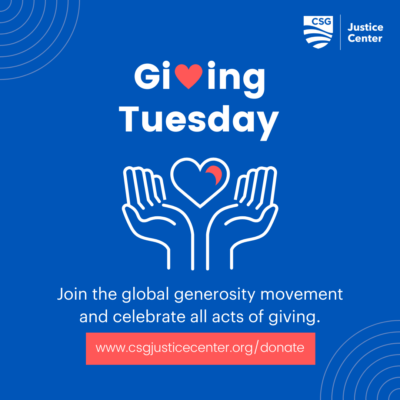 This Giving Tuesday, Help Us Break the Cycle of Incarceration, Uphold Justice, and Offer Second Chances
Read More
This Giving Tuesday, Help Us Break the Cycle of Incarceration, Uphold Justice, and Offer Second Chances
Read More
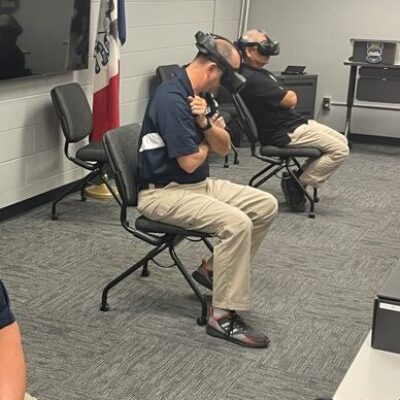 Empathetic Policing: Mason City Police Department Launches Virtual Reality Training Program to Help Officers Better Understand Behavioral Health Crises
Read More
Empathetic Policing: Mason City Police Department Launches Virtual Reality Training Program to Help Officers Better Understand Behavioral Health Crises
Read More











